

Part of NewFormat AB Portal
 
OpenFormat
Products and Services
Offerings / Promotions / Prices
Guides and Datasheets
Customer Contact Form
Home/NewFormat
NewFormat AB
PDF standards make the world work
NewFormat makes PDF information permanently
accessible, searchable, readable and reusable
for the future and for as many people as possible.
We leave no file behind.
We create accessible PDF in compliance with the ISO Standard PDF/UA.
Our solutions are based on
recognized ISO Standards based on PDF technology
and tested, reliable, and highly accessible software solutions from
the PDF Association vendor community.
|
Open standards
ensures that your digital data and information is
available and accessible in the future for as many as possible
when today's IT technology, IT products and IT vendors
are no longer
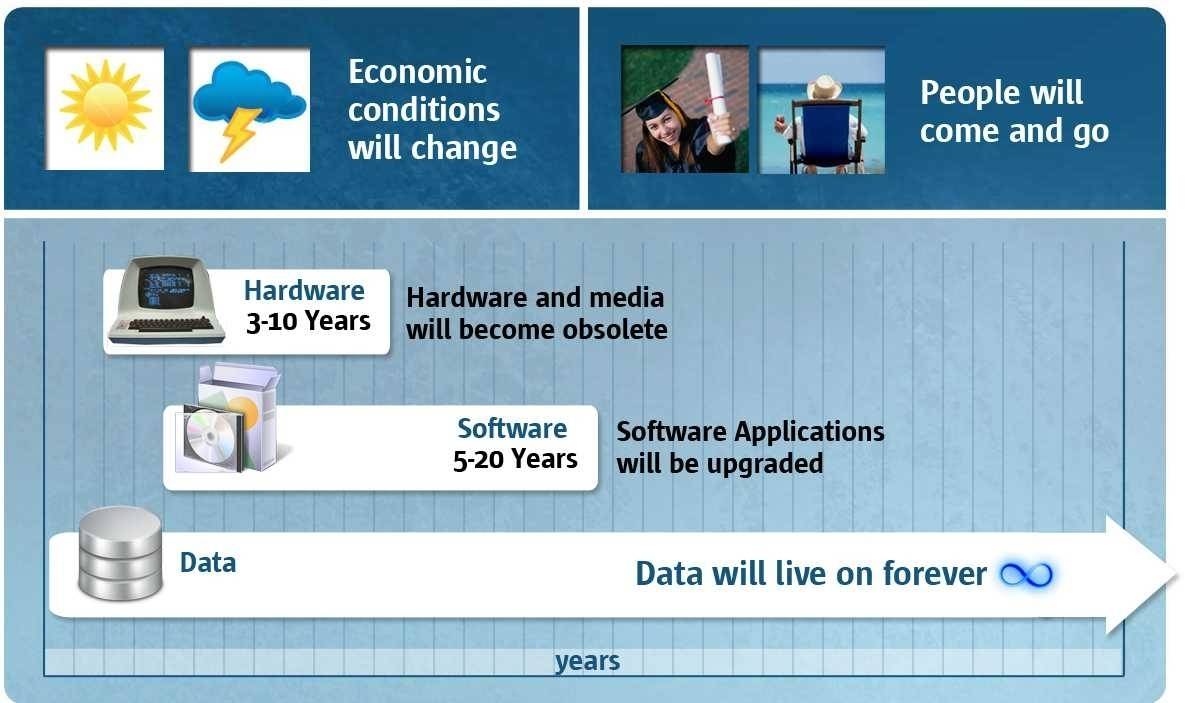
|

Accessible PDF
A fully PDF/UA compliant PDF can be just as
accessible as a WCAG compliant website
|
Here you will find everything you need to know to successfully
create Accessible PDF according to ISO Standard PDF/UA!
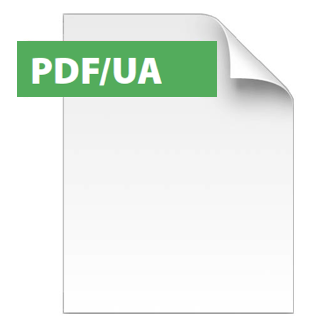
For a PDF to be considered digitally accessible
it shall be compliant with the accessibility standard ISO PDF/UA
and applicable parts of the W3C/WCAG 2.x AA recommendations!
Welcome to NewFormat's web pages on digitally accessible documents
based on the Portable Document Format (PDF).
These web pages focus on informing about what is required for a
PDF document to meet the requirement of being digitally accessible,
applicable accessibility laws and accessibility standards for digital documents,
and examples (from real life) of both accessible and inaccessible PDF documents.
We also point out that as a result of imperfections in
several of the most popular and used software tools to
create and edit PDF documents they often lack the ability
to always correctly export accessable PDF documents.
The exported PDF file thus risks not being a
"digitally accessible PDF", nor meet accessibility requirements
according to the EU Web Accessibility Directive
or the Swedish Act on Access to Digital Public Services!
To press only a few buttons in these programs
usually does not lead to a successful end result.
It is therefore utmost important to always critically
examine and validate the exported PDF file for accessibility
before it is published.
Below is advice and tips on well-proven alternative/supplementary
software, assistive technologies, and services, that are offered on
the market and that are specifically designed to facilitate and
substantially reduce working time to create and maintain
digitally accessible PDF documents.
In addition, and not least important,
we specify the requirements you must make to internal or external
contractors for them to create digitally accessible PDF documents.
Accessible(!) and useful(!) PDF documents that your business then
safely can publish and distribute in accordance with
the requirements of current accessibility laws.
What characterizes a digitally accessible document?
A digital or electronic media, that is available on computer screens,
in mobil apps, or other assistive technologies, is digitally accessible,
when it is easily opened, read, understood and can be navigated
by everyone, with or without disabilities.
The aim of a barrier-free and accessible PDF document is to
ensure that all users, regardless of their personal limitations,
have equal access to the content of the PDF document
(possibly with the support of assistive technology),
and have equal opportunity to act on it and make own decisions
without the help or participation of others.
For a PDF to be considered digitally accessible it shall at least
be compliant with the digital accessibility standard ISO PDF/UA
and applicable parts of the W3C/WCAG 2.x AA recommendations;
WCAG is a comprehensive set of recommendations to specifically
make web-based content more accessible to everyone.
More on this below.
We would be happy to help you
create accessible PDF on your own.
But, what do you do if you are responsible for thousands of PDFs?
You may not necessarily know where they all are,
or you may not have the time and resources to
check your files one at a time.
Then we can help you out.
NewFormat provides software and services to businesses that wish to
create accessible PDF documents according to the ISO standard PDF/UA;
either on its own ("Do-It-Yourself / DIY") or as "Accessible PDF as a Service".
Should the necessary own work effort feel overwhelming,
we are happy to help by instead delivering accessible PDF documents
as a service to your business;
from single documents to many thousands of accessible PDF documents,
from simple documents to complex annual reports/publications/magazines.
Feel free to read our information below in peace and quiet at your own pace.
You will certainly then be well prepared to make the decisions that make
your business, from now on, successful in creating and publishing
digitally accessible PDF documents;
PDF documents that are thus accessible to EVERYONE in our country.
Welcome to contact NewFormat about software and services
to build a more accessible digital society.
Best regards,
Kent Åberg,
Managing Director, NewFormat AB
Quick Links:
Pod (in Swedish) about
and specifically
with Ola Karlsson (Branschkoll) and Kent Åberg (NewFormat)
This pod can also be downloaded for listening from:
Interesting?
|
Portable Document Format - PDF
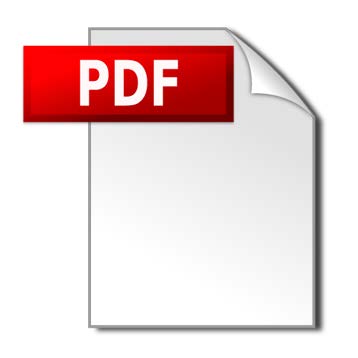
PDF today
Digital information that is worth saving and shared with others
is often saved as a digital document in the form of
Portable Document Format, better known as PDF.
PDF is used today by everyone, from individual users to
large-scale complex digital ecosystems to create, distribute,
share and store digital business information.
Digital business information that defines how websites
(with HTML / CSS / JavaScript pages, images, videos),
contents and digital documents are exposed to visitors.
PDF, the world’s chosen electronic document format,
celebrated 30 years on June 15, 2023.
Adobe then conservatively estimated that there are
more than 3 trillion PDF documents on the planet
with new use cases emerging every day.
Every year billions of PDF documents are created
around the world. Adobe Document Cloud alone opens
more than 300 billion PDF files each year.
PDF is the best format for paginated content requiring
a precise and repeatable appearance.
PDF is the format of choice for every kind of document and
is used in all industries, government and by all citizens.
Think of all office documents, presentation slides, protocols, reports,
investigations, plans, contracts/legal documents, prospectus,
annual reports, press releases, white papers, brochures,
laws and regulations, sales/marketing/information material,
forms, customer magazines and journals,
educational/course/training material and resources,
books, parking tickets, artwork, food packaging, tax forms,
vaccination certificates, and other digital documents that citizens,
employees, customers and site visitors view and download every day
from internal and external websites.
PDF is also at the heart of manufacturing and engineering communications.
PDF technology supports manufacturing worldwide, conveying ideas,
plans, communications, agreements, specifications, contracts…
and of course, 2D and 3D drawings and supporting content
throughout complex workflows and across corporate,
organizational and process boundaries.
PDF is simply trusted by everyone to reliably
communicate accurate information.
In fact:
PDF is the 2nd most popular file format on the web (after HTML), making it far more popular than
DOCX, XLSX, PPTX, and EPUB, and even far more popular
than image files like JPEG, PNG, and GIF.
Googles Trends data shows that the number of web searches for "PDF"
has increased dramatically over time;
it is clear that PDF is a technology that is
more relevant than ever before.
Many websites are mostly used as navigation sites
to help visitors find a specific PDF.
Not least this applies to the Swedish public sector
where many millions of digital PDF documents
are created every year.
A large portion of these documents are published on
public websites for access by the general audience.
A clear evidence that the PDF technology serves as an appreciated,
reliable and very often preferred digital communication and information
platform by our authorities.
Quite simply, the world runs on PDF; let’s face it.
Large amounts of important and valuable information
are stored in these digital PDF documents.
But in too many cases, these PDF documents are unfortunately not
designed and created in such a way that all citizens are even given
the opportunity to access the information to be able to act on it.
PDF is today far from being a printing solution only
To most end users, PDF is simply a reliable, printable page.
However, most PDF documents created are never printed on paper,
but saved and shared as digital files in computer systems and networks.
Thus, PDF is the default way to share a digital version of a print document.
Informed users know that PDF also performs as a critical workflow enabler,
a multipurpose content vehicle for digital publishing, and
a powerful and globally supported format for long-term archiving.
PDF is a page-based technology, thus the term "page" is frequently used.
But many sectors and PDF applications don’t print, share or publish pages.
For example, you may be designing for labels, packaging,
industrial print, book covers, signs, or even textiles.
So, if you are not printing, sharing, publishing pages,
you can translate "pages" to the format most
appropriate for your use case.
PDF technology goes far beyond the format.
PDF enables digital document solutions on every continent,
in every language, in every business and public sectors worldwide.
PDF is a reliable format for your valuable digital information resources.
PDF viewing capabilities are an essential part of any operating system
(even on mobile devices), and indeed, today all modern web browsers
offer built-in PDF viewers.
PDF is an important part of the digital transformation
Digital document formats, PDF in particular,
are at the center of the ongoing digital transformation.
PDF is a core technology of the digital online world,
today and in the future.
The ISO-standardized PDF technology is indispensable.
PDF files are shared, displayed, read/consumed and
digitally signed on computer screens and on mobile devices;
they can even be managed, navigated and rendered by
assistive technology devices for those who need.
PDF-based technology is integrated in an infinite number of
digital solutions and innovative ecosystems,
thereby enabling digital business development for:
- automation of workflows and processes
- workgroup collaboration
- document long-term archiving
- document signing
- document indexing
- document and text search
- document encryption
- document redaction
- digital publishing
- content reflow/responsive viewing
- transactional data / variable data
- embedded collections of three-dimensional objects
(3D models, 3D PDF)
- accessibility for everyone to digital information and services
- ... and many more application areas
|
Accessible PDF

Digitization means inclusion and accessibility.
All individual citizens have the right to access all types of
government information; both in analog and digital form.
Barriers that prevent interaction with or access to digital
documents or websites can be considered as discrimination.
If a digitalt document cannot be read and navigated by everyone,
including individuals with vision impairments or other disabilities,
then it is not a digitally accessible document.
It is also not a useful document for everyone.
For a digital document to be useful for everyone
it is required that it is at least designed and published
as a digitally accessible document.
Sweden as a nation is bound by international and Swedish
regulations to ensure accessibility for everyone:
- the UN Declaration on Human Rights,
- the UN Convention on the Rights of Persons with Disabilities,
- the Swedish Anti-Discrimination Act,
- the Swedish Public Procurement Act,
- the Work Environment Act,
- the Swedish Language Act,
- the EU Web Accessibility Directive implemented as
the Swedish Act on Access to Digital Public Services,
SFS 2018:1937 & SFS 2018:1938.
Note! This Act also applies to older digital documents if they are
needed in order for the authority to be able to carry out its mission.
SFS2018-1938 says:
"2 § of the Act (2018:1937) on accessibility to digital public services
is not applicable to digital service consisting of
1.file format for documents published before
September 23, 2018, if such content is not needed for
to carry out the active administrative procedures which
follows from the relevant public actor's charter,..."
In Sweden, the Agency for Digital Government (DIGG) is
designated supervisory authority for compliance with
the Swedish Act on Access to Digital Public Services.
According to DIGG's interpretation, the following applies:
"Regardless of whether there is an accessible alternative
in the form of an e-service documents used in the business
shall comply with the requirements for accessibility."
It is therefore not possible for an authority to try to "round" the DOS act
by referring to the following (all too common) prompts on their website:
- "Click here to print the PDF document"
- "Contact us to get an accessible PDF"
- Upcoming: The European Accessibility Act (July 28, 2025)
Declarations, conventions, directives and acts that are technology-neutral.
Regardless of the technology (web/HTML, PDF,...)
used to publish a digital web-based service, the media type used must be
published in a form that it is accessible for everyone in the community.
The Swedish national value base is based on our constitutions and laws
and therefore every authority's management has the responsibility to
ensure that the authority's operations are conducted in accordance
with the principles and other legislation.
Swedish authorities are thus since long bound to comply with
and apply these regulations in their daily operations.
Authorities are also in the role of employer responsible for that
employee work material is accessible and well functioning.
What is Digital Accessibility?
Digital accessibility means complete barrier-free access to
all information available through a computer or mobile device.
So whether it is a website, mobile app, webinar or a document,
everything should be accessible for everyone.
PDF vs Web - Key Differences to Consider
Today HTML-based web pages are more capable and dynamic than ever,
but they are no more "documents" than they were when
the World Wide Web was launched back in 1990s.
Since the launch of the Portable Document Format (PDF) in 1993,
the usage of PDF and the number of PDF applications continue to grow.
That’s because PDF technology; as a self-contained,
reliable and flexible portable document format,
is key to digital transformation.
PDF does what other web technologies do not.
Accordingly, PDF does not compete with HTML;
PDF complements HTML.
W3C/WCAG is a wide range of recommendations for
making web content more accessible for everyone.
W3C/WCAG is technically neutral, and generally deals with web content;
WCAG does not directly address offline documents, making direct
application of WCAG rules and techniques on PDF less obvious.
As WCAG is fundamentally oriented towards web content rather than
web-independent content, WCAG can be difficult to apply to PDF,
so it's useful to begin by reviewing fundamental distinctions:
- A website generally consists of one or more webpages consisting of
multiple HTML files, CSS, database entries, scripts and other sources.
Although links facilitate presentation of webpages as part of a
whole body of content, each webpage is an independent entity
defined by its URI.
- A PDF document, by contrast, is a single file containing from
one page to thousands (or even millions) of pages of
text, graphics, annotations and other content.

Source: PDF Association
On the left is a table of contents in a PDF document,
on the right a website map
Can a PDF be Accessible for Everyone?
Yes, of course! - A fully PDF/UA compliant PDF can be just as
accessible as a WCAG compliant website!
File type techniques like PDF and HTML are not by default accessible.
A PDF can be made an accessible PDF,
just like an HTML-based web page can be made accessible.
The reality is that accessibility is not dependent on the file type,
but the work done to make it accessible.
Neither PDF documents nor HTML pages become accessible
because of their ability to become accessible.
They become accessible because of the trained work put into it.
An HTML page without that work is inaccessible regardless of its capability.
Of course so is PDF.
The PDF specification provides robust support for accessibility.
The accessibility of any individual PDF file depends on
how well the author prepared the file for accessibility.
The accessibility of the experience for the end user depends on
how well the PDF viewer application supports
the accessibility features in the specification.
Achieving accessible PDF or accessible HTML
typically requires special tools and skills;
see more below.
PDF is since 2012 adopted to support digital public services
PDF has since 1993 served many millions of users and businesses
as the globally preferred digital document format.
The PDF technology is today even more developed and is since 2012 adopted to
also meet today's requirements for accessibility for all to digital public services;
see more under "Accessible PDF" below.
Right now, the reliability and robustness of PDF technology,
based on a fixed layout page-description model, is merged with
the agility, flexibility and elegance of Web and HTML technologies;
in order to provide the best possible user experience
(such as support for reflow) on each type of device and use case.
What is Accessible PDF?
A digital or electronic media, that is available on computer screens,
on mobile devices, or other assistive technologies,
is accessible when it is easily opened, read, understood and
can be navigated by everyone, with or without disabilities.
The aim of a barrier-free and accessible PDF document
is to ensure that all users, regardless of their personal limitations,
have equal access to the content of the PDF document
(possibly with the support of assistive technology),
and have equal opportunity to act on it and make own decisions
without the help or participation of others.
Barrier-free access and accessible PDF content is all about
universal design; i.e. accessibility through design.
Use of universal design and standards ensures that as many people
as possible can use and understand your PDF documents.
Good design for digital accessibility for everyone ensures
no subsequent adjustment is required for the needs of
a specific target group of individuals.
Note!
The tricky thing about digitally accessible and inaccessible
PDF documents is that they, in most cases, look the same.
In other words, they are often visually identical.
Therefore, it’s almost impossible for most users to tell
whether the PDF they are looking at is accessible
by merely looking at their physical view.
What many people don't know is that PDF files can contain
an invisible structure layer that is similar to HTML.
The structure elements, that build this structure layer,
are called "PDF tags".
Think of them as name plates that are attached to each
content element and convey additional information such as
“I am a first-level heading” or “I am a list with 3 entries”.
PDF page view with related PDF tags

Source: axes4.com
Such additional information makes up the essential part of an accessible PDF.
They make the content machine-readable and enable assistive technologies,
such as a screen reader, to present the content appropriately,
independently from the visual page view.
WCAG's recommendations on accessibility for everyone to digital
web content emphesizes the need good visual and editorial web design.
However, digitally accessible PDF (according to PDF/UA) is not about
visual appearance or editorial design, but about applying digital
accessibility standards to define an internal technical description of
the contents of the PDF document so that accessibility devices and
assistive technologies can accurately manage, navigate,
and reproduce the content.
Digital Accessibility Standards.
Compliance with WCAG is required for
all content on accessible websites.
For PDF documents,
compliance with the ISO Standard PDF/UA is also required.
The overall purpose of the WCAG recommendations and
the PDF/UA standard respectively is to facilitate the creation of
digitally accessible web pages and PDF documents.
Websites are technically built with HTML and CSS code supplemented
with digital information content of mainly these media components:
- text
- pictures
- sound
- video
- documents and presentation slides, and
- graphic illustrations
Regardless of technology (web/HTML, text, .png, .jpeg, mp4, PDF, .docx, .key,...)
used to publish a digital web-based service, the media type used must be
published in a form that it is accessible for everyone in the community.
Website owners often refer to:
- "We focus on making the HTML-based content accessible".
- "We prioritize our regular business"
- "To make the website accessible, including all documents,
requires too much time and work/unreasonably burdensome,
and we don't have the budget for that"
- "We have no disabled visitors on our website"
- "We intend to do that when we rebuild our website next time
(ie, at some unspecified time far into the future)"
However, according to the EU's Web Accessibility Directive,
which is technology neutral, that is no longer a valid excuse.
The website owner cannot continue to publish inaccessible
PDF documents.
DIGG states that "unreasonably burdensome" is an exception provision;
i.e. an unacceptable reason for an authority not to accessibility adapt
the authority's inaccessible documents.
To ensure unrestricted access to PDF-based information in
every respect, PDF files must meet certain requirements.
This also applies to cases where website content
(such as web pages, articles, blogs, etc.)
is converted to PDF that in turn is
published or shared with others.
Accessibility standards ensure that even PDF documents
work well with screen readers and other assistive technology.
For a PDF to be considered digitally accessible it shall at least
be compliant with the digital accessibility standard ISO PDF/UA and
applicable parts of the W3C/WCAG 2.x AA recommendations,
(and in the USA, ADA and Section 508).
For files based on PDF-technology,
universal accessibility requirements are since 2012 defined by:
Successful e-government presupposes that all
digital government information is accessible for all citizens
- the success is dependent on "Accessible PDF":
WCAG and PDF/UA complement each other.
The Web Content Accessibility Guidelines (WCAG)
are the internationally recognized guidelines for accessible web.
Many national or supranational regulations (eg at EU level)
on the accessibility of web sites refer to WCAG.
The WCAG recommendations emphesize good visual and editorial web design.
All information on a website must be accessible for everyone based on
four main principles which state that content must be "POUR":
- Perceivable,
- Operable,
- Understandable, and
- Robust
PDF/UA is a required complement, not an alternative, to WCAG.
PDF/UA is consistent with WCAG, but far more technically specific,
and provides a clear-cut means of affirming that a given
PDF document meets high standards for digital accessibility.
Compliance with PDF/UA is important for digital accessibility for everyone.
PDF/UA defines the technical requirements that must be considered
when a PDF document must be universally accessible for everyone;
with or without disabilities.
The PDF/UA standard specifies HOW relevant PDF content
(such as semantic content, text content, images,
form fields, comments, bookmarks, and metadata)
shall be used in PDF/UA compliant documents.
Properly tagged ("well-tagged") PDFs are essential and
a prerequisite for accessibility so that screen reader devices
for visually impaired people or reading software for
users with learning disabilities can provide
rich access to a PDF’s content.
PDF tags are also an effective method to improve
Search Engine Optimization (SEO).
Even automated extraction of information/text content from
PDF documents is easier to execute with well-tagged PDF:
Inaccessible PDF vs Accessible PDF
Relations and dependencies between
PDF, PDF/UA, WCAG, Usability and Accessibility / Accessible PDF.
To meet PDF accessibility requirements is like a "mountaineering expedition".
The reach of a camp builds on the reach of all previous camps.
The route goes from PDF (Camp 1),
via Universally Accessible PDF - PDF/UA (Camp 2),
Relevent Accessibility Parts of WCAG (Camp 3),
and PDF Usability (Camp 4), to the mountain top,
a PDF that is Usable and Accessible for All Users:
- Camp 4: Usability
- Camp 3: WCAG - Web Content Accessibility Guidelines, ISO 40500
- Camp 2: PDF/UA - Universally Accessible PDF, ISO 14289
- Camp 1: PDF - Portable Document Format, ISO 32000
Accessible PDF
requires compliance with ISO Standards,
PDF/UA and (relevant accessibility parts of) WCAG

Source: axes4.com
PDF documents complying with PDF/UA
are universally accessible for everyone.
In order to create a document that is as accessible as possible to everyone,
one needs to focus on all potential user groups and their needs.
One should never succumb to the temptation to optimize a
PDF document for a specific user group.
The consequence of this could be that such a document is then
very readily consumable for this one group of users,
but may be more disadvantageous than beneficial for others.
Important!
How well a PDF document is "accessible for everyone"
depends on how the document is created.
The level of accessibility according to current accessibility standards
is determined by both the execution of the editorial content of
the document AND of its internal technical structure.
Often, this insight is neglected by many, which can lead to significant
problems when it comes to fixing inaccessible documents.
Digital documents provided for download on a web site are
also covered by WCAG per se and must meet the applicable
success criteria to comply with WCAG (Level A, AA or AAA).
It is definitely best to first conduct an editorial accessibility check of
the design and content according to the WCAG recommendations.
The editorial content of the PDF document must be WCAG compliant
before it is tested with respect to PDF/UA, the technical requirements
for "accessible PDF".
But, WCAG's recommendations alone are not enough
to make a universally accessible PDF.
Note!
For the technical implementation of accessible PDF,
compliance with the ISO Standard PDF/UA is also a requirement;
a PDF file can be compliant both with WCAG and PDF/UA.
A fully PDF/UA compliant PDF can be just as
accessible as a WCAG compliant website.
A successful validation of a PDF document for compliance with
PDF/UA and WCAG 2.x AA, always requires the PDF document
to pass at least two stages of validation before it is
published or shared with others:
- a programmatic syntax test,
which can be performed by a trusted software, and
- an interactive semantic test,
manually carried out by a human.
Successful barrier-free access to content within PDF documents
depends not just on PDF/UA compliant documents, but also on
requirements for PDF/UA compliant programs and assistive technology:
- a PDF/UA compliant document
(according to standards and guidelines),
- a PDF/UA compliant display or processing program,
- a PDF/UA compliant assistive technology,
(such as a "PDF/UA-Ready" screen reader)
Please be aware:
W3C/WCAG clearly says:
Organizations requiring all web content to only use
W3C’s published techniques are wrong! "W3C recommends that the only thing that is required
is meeting the WCAG 2.x success criteria." "The basis for determining conformance to WCAG 2.x is
the success criteria from the WCAG 2.x standard - not the techniques." "W3C’s Techniques for WCAG 2.x document is informative
(that is, not required, non-normative)."
Thus, it is not the assistive technologies, nor popular software tools such as:
MS Office, Adobe InDesign, Adobe Acrobat, Google Docs, Apple iWork,...
that define what is an accessible web or an accessible PDF.
Never adapt PDF documents to a specific assistive technology or software.
Instead, always adapt PDF documents to its digital accessibility standard: All you have to do is to create ONE version of a PDF/UA compliant document,
and the manufacturers of the relevant programs and assistive technologies are
in turn responsible for complying with this global digital accessibility standard.
This results in ONE PDF:
that anyone can use,
regardless of functional ability and/or need for
special technical aids to be able to consume
the content and navigating the information, and over time you only need to maintain/update ONE document,
instead of many different variants of the same document,
which in turn saves many working hours.
- Furthermore, WCAG and PDF/UA are entirely complementary:
- WCAG provides requirements regarding content accessibility;
- PDF/UA provide requirements
that ensure accessibility in the PDF context.
The best practice for document authors
producing accessible PDF files is to:
- consider WCAG’s requirements
when designing and creating content;
- use software capable of meeting
PDF/UA requirements to produce the PDF files.
Barrier-free also means multi-channel-capable
The demand for universally accessible information
is not restricted to the needs of disabled individuals.
Content now must also be generated and
made available as intelligently as possible.
That also includes the language
(comprehensibility, syntax, multilingualism).
In other words, the demand is also for documents with meaningful data
that can be extracted and linked as desired, for example to conduct
highly complex and targeted information research:
PDF on Mobile Devices / Small Screens
Based on the premise of a fixed layout, the PDF page-description model
was developed during a time where documents were exclusively viewed
on desktop monitors, or printed.
Recent years advent of much smaller screens, and screens of many sizes,
presents a variety of challenges and opportunities in the PDF paradigm.
The global IT industry and the global PDF industry are now, as we speak,
implementing innovative solutions (like the Adobe Liquid Mode for Acrobat Mobile)
to accommodate this challenge:
Interesting?
|
Who shall use PDF/UA for Accessible PDF, and when?

Ensuring that digital documents are accessible for everyone is not just a good idea:
it is in fact completely in accordance with current law.
The law aims to counteract discrimination.
Public authorities have a special responsibility to comply with the law.
This is not something that the Swedish authorities
can choose to do or not do.
Authorities are obliged to acquire the necessary knowledge.
The option to just opt out of publishing
digitally accessible documents does not exist!
An authority that publishes inaccessible digital information
thus withholds information intended for all citizens
from reaching out precisely to all citizens;
which in itself may constitute a form of discrimination.
It can also be a form of defiance of the law.
It does not have to be that way.
PDF/UA is relevant and directly applicable for all entities,
in public sector and elsewhere, concerned with conformance
to regulations requiring access for everyone to
documents based on PDF technology
Since 2009 it is mandatory (according to the National Archives' regulations)
for Swedish authorities to use the standard PDF/A-1 for electronic archiving
of office documents and other digital documents.
PDF/UA is a complementary, process-based standard
which is applicable to Swedish authorities and entities,
to make public digital documents universally accessible for everyone.
A PDF document can simultaneously meet several standards,
for example, both PDF/A-2a and PDF/UA for long-term archiving of
an accessible digital PDF document.
Legal requirements for accessibility to digital information for
everyone in the society (e.g. the EU Web Accessibility Directive,
the Swedish Act on Access to Digital Public Services,
the Swedish Discrimination Act, the German BGG, BITV and mandate 376)
ensures that all users, regardless of functional ability, have equal access
to information and functionality on the web and in PDF documents.
Accessible PDF files are fundamental for barrier-free access to
digital information from eGovernments/public administrations
and enterprises serving the public sector.
Also entities serving the public sector, like media service providers,
advertising/communication agencies, banks, finance and insurance entities,
organisations and institutions as well as lecturers at colleges and universities
that are required to provide documents/course materials
in the form of accessible documents.
Documents on websites, especially PDF files, can be a significant
risk of liability even if the site's HTML content itself is fixed.
Avoid litigation risks by ensuring that all PDF documents on the
web are accessible for everyone; with or without disabilities.
(The regulations are much stricter internationally,
for example in the USA and in Ontario/Canada, where also websites
in the private sector, incl. schools / universities, are included,
with the result that several businesses and universities have been
sentenced to pay large sums in damages to persons who consider
themselves to be discriminated due to inaccessible websites and
inaccessible documents published there).
In 2025, the EU Accessibility Directive will enter into
full force in Sweden, where the accessibility requirements are
extended to also apply to products and services and other
sectors of the society, such as for banking and finance.
Then we can expect that even PDF documents that are automatically
generated in very large volumes from authorities and others businesses'
central IT systems and databases must be designed and shared as
digitally accessible PDF documents.
Typical types of documents are invoices, notices, pension notices,
bank statements, funds dividend notices, reports, agreements, forms, ...
which are all produced and distributed as part of automatic workflows
and in very large quantities (maybe hundreds of thousands) every day.
Then the digitally accessible PDF will also be a
question for the IT department to solve.
It's critical to publish documents that are digitally accessible for everyone,
also for individuals with vision and hearing impairments, mobility challenges,
cognitive, and other disabilities.
Apply PDF/UA and make a difference to your audience.
By publishing PDF documents that are accessible for everyone
all citizens have equal opportunity to access and act on
valuable digital information.
Recommendation:
For all forms of internal/external ordering of PDF-based documents
the following shall be included as firm requirement:
"The PDF documents SHALL be delivered as accessible PDF
according to the ISO Standard 14289 (PDF/UA)"
Please be aware,
to quickly make accessible PDF by pressing a few buttons
in a program does not usually lead to a successful final result.
You need a certain amount of basic knowledge in
digital accessibility standards.
The extent of this knowledge depends largely on
the nature of your documents and content.
Are you confident that your business internally has the skills and
the right tools to create PDF documents that are guaranteed
to meet the PDF/UA Standard?
If not,
hire NewFormat to provide Accessible PDF as a Service.
Accessible PDF as a Service is for anyone who does not have
the opportunity to create accessible PDF files on their own,
but who nevertheless want PDF documents to comply with
accessibility regulations and standards.
Interesting?
|
Common ways to create of accessible PDF documents

Common methods for the creation of accessible PDF documents:
The direct method based on source format: If you want to create accessible PDF documents with authoring
software like Microsoft Word, Adobe InDesign, Adobe Acrobat,
or if you want to convert a structured format like
HTML or XML into PDF, you usually click
the magic “Create PDF” button.
If the conversion software does a good job,
the necessary internal tag tree is created automatically
and in a high quality.
The indirect method based on an existing PDF file: If the source file is not available or if the authoring software
doesn’t do a good conversion job, you can take the PDF without tags,
generally a web-PDF, and rework it.
During this process you tag every relevant content element and
add some additional accessibility features like alt text to figures.
For doing this you need a software tool, a PDF editor,
that is capable to create and edit PDF tags.
But do not expect too much.
Only very few software programs offer inbuilt support
to create high-quality PDF/UA compliant documents
out of the box or at least with less effort.
Interesting?
|
Glossaries for PDF and Accessible PDF

Get to know the language, acronyms and terms of PDF.
Below listed glossaries describe commonly encountered
acronyms and terms for PDF and PDF-based substandards
(like PDF/UA for Accessible PDF, PDF/X for print, and
PDF/A for archiving and long-term preservation)
with easily understood lay-person definitions.
Typical non-technical users, such as ordinary end-users,
consumers, and business decision makers will benefit
from these glossaries when encountering
the more technical aspects of PDF,
when communicating with PDF vendors and/or
design/production/communication agencies,
or when they need to understand ISO standards
for various PDF-based technologies:
Interesting?
|

Recommended Reading on PDF/UA
The ISO Standard for Accessible PDF Documents and Forms
|
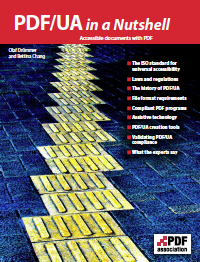 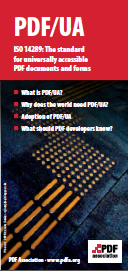
(For download of these guides, click on the pictures above)
|

Do you need help to create accessible PDF in compliance with PDF/UA?
To prepare a few or limited number of PDF documents for universal
accessibility can be daunting task, although possible to accomplish.
But, what do you do if you are responsible for thousands of PDFs?
You may not necessarily know where they all are, or you may not
have the time and resources to check your files one at a time.
With vast numbers of enterprise PDF documents stored on websites,
networks, and computers, organizations are challenged with
keeping tabs on accessibility standards compliance.
Many businesses also need to daily produce
very large amounts of accessible B2B/B2C PDF documents
(such as invoices, bills, account statements, insurance policies, bookings,...).
PDF documents typically created in real-time by internal business systems
and thus put high demands on efficient automation of workflows.
Then we can help you out.
NewFormat provides tools and services for creation,
checking/validation and remediation,
to make your PDF documents truly accessible
for everyone according to the ISO Standard PDF/UA;
from single documents to many thousands of accessible PDFs,
from simple documents to complex annual reports/publications/magazines.
Delivery time for a single document:
Depending on how complex the document is and the number of pages.
Simpler documents: Usually within 1-2 working days.
More complex documents: Usually within 5-10 working days.
We also help businesses to locate, map and analyze existing
document resources as input for decision on needed actions to
achieve full compliance with accessibility standards.
Our services can automatically and regularly crawl and scan
internal and external websites, and other document repositories, ....
to locate existing document issues and compile an issue-report
based on the findings.
The status reports indicates the accessibility status of
the PDF documents over time; including measures needed to
remediate PDF documents for full PDF/UA compliance.
Such fact reports are of indispensable value as a basis for your
entity's continuous accessibility work and accessibility reports.
Tools and services for successful use of
PDF/UA for accessible PDF
Audit mapping of document resources on your websites/domains
We offer subscription services where we crawl and scan
your websites/domains according to some desired regularity;
e.g. once a year, every six months, every quarter, every week,...
Provides insight into the status of existing PDF documents
with respect to accessible PDF.
Interesting?
|
More Information and Resources

Accessible PDF (PDF/UA) for Accessible eGovernment
Samples of Accessible PDF Documents - Accessible for Everyone!
Tools for Creation of PDF/UA Compliant PDF Documents
Accessible PDF as a Service - PDF/UA Services
Training in PDF Standards
Next-Generation PDF
|

Warning for Inaccessible PDF!

Samples of Inaccessible PDF Documents - Not Accessible for Everyone!
|
For more information contact NewFormat
NewFormat AB
Smörblommegränd 14, SE-165 72 Hässelby (Stockholm), Sweden
tel:+46 (0)70 631 53 01
All content © copyright 2008-2025 NewFormat AB. All rights reserved.
All product names, trademarks and registered trademarks
are property of their respective owners.

Accessible PDF
|



















